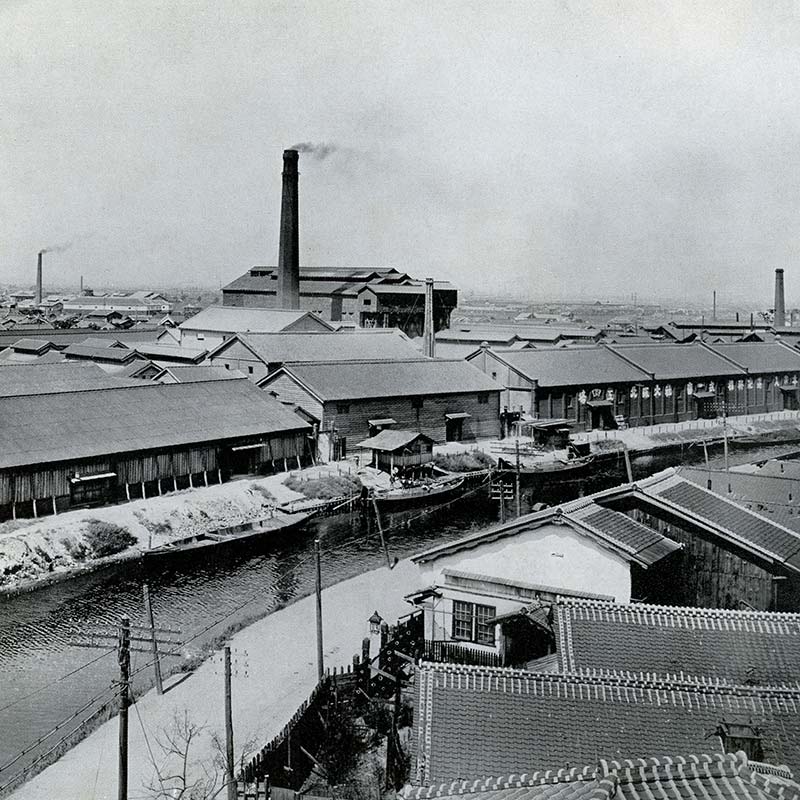Young girls and women at work at a bamboo basket factory.
When Japan’s leaders during the Meiji Period (1868-1912) started the country’s sprint for economic development, they forever changed the roles of Japanese women. Many of them ended up working in the countless factories that were sprouting up everywhere. Without the willingness of Japanese women to work long hours for little pay, Japan would never have succeeded in its industrialization. The numbers bear this out. In 1894, for example, 90% of cotton factory workers were female.1 They often worked under absolutely inhuman conditions.2
During the Edo Period (1603-1868), Japanese society was built on Confucian beliefs with its strong respect for hierarchy and elder generations. The smallest unit of society was not the individual, but the household, the so called ie (家), consisting of grandparents, their son and his wife, and their children. The ie system and Confucian values of filial respect created for each family member a clear purpose and place that relegated individual needs below those of the household.
Interestingly, this often enlarged the role of women beyond breeding and caring for the children. Rearing children was seen as the responsibility of the whole household and not just the mother. At the same time, the financial well-being of the ie was also seen as the responsibility of the whole household and not just the father. As a result, especially in rural families women played an important role in their households and actively participated in agriculture and handiwork. Edo Period women often had far more freedom and rights than is these days assumed, but it all depended on the social class the woman belonged to. The lower the class, the less rigid the rules.3
The reforms of the Meiji Restoration changed this. The government entered the Japanese household. Gender differences were created or enforced. New legislature was passed to make the eldest son the legal heir. Women lost political and property rights and were now taught to be good wives and wise mothers (良妻賢母, Ryosai Kenbo). Incidentally, a slogan that was only born during the Meiji Period.
The disintegration of the household was further hastened by a second overriding goal of the Meiji Period, to enrich the country and build a strong army (富国強兵, Fukoku Kyohei). Newly built factories needed cheap and able labor. Instead of family members working side by side on the fields, they worked separately in factories.
With most family members not around anymore to help with raising the kids, women were now expected to stay at home after marriage. What today is still seen as traditional Japanese gender roles was actually the result of Japan’s drive to “modernize” during the Meiji Period. The Meiji reforms separated men, women and children and gave them pre-destined and inflexible roles. It also helped to destroy the ie system. As early as 1920, no less than 54% of Japanese households were nuclear families.4
Notes
1 Kiguchi, Junko. Japanese Women’s Rights at the Meiji Era. Retrieved on 2008-07-21.
2 Department of History, Pacific University. The Japanese Woman. Retrieved on 2008-07-21.
3 Penn State University. Good Wives and Wise Mothers 良妻賢母. Retrieved on 2008-07-21.
4 Wikipedia. Ie (Japanese family system). Retrieved on 2008-07-21.
Published
Updated
Reader Supported
Old Photos of Japan aims to be your personal museum for Japan's visual heritage and to bring the experiences of everyday life in old Japan to you.
To enhance our understanding of Japanese culture and society I track down, acquire, archive, and research images of everyday life, and give them context.
I share what I have found for free on this site, without ads or selling your data.
Your support helps me to continue doing so, and ensures that this exceptional visual heritage will not be lost and forgotten.
Thank you,
Kjeld Duits
Reference for Citations
Duits, Kjeld (). 1904: Bamboo Basket Factory, OLD PHOTOS of JAPAN. Retrieved on November 27, 2025 (GMT) from https://www.oldphotosjapan.com/photos/306/bamboo-basket-factory




There are currently no comments on this article.